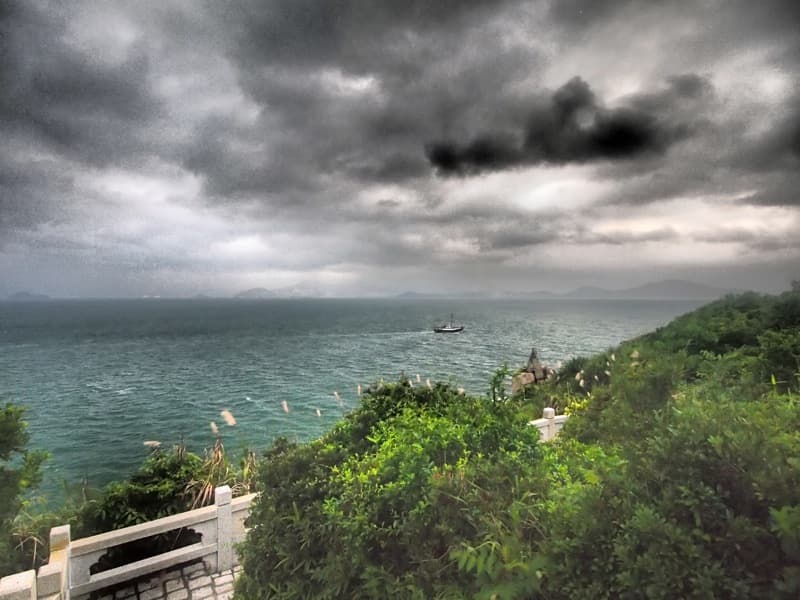- This topic has 5 replies, 2 voices, and was last updated 11 years, 11 months ago by
DocMartin Williams.
- AuthorPosts
- 9 May 2012 at 8:06 am #7304
At dawn on 21 May, an annular eclipse will be underway and, weather permitting, visible from Hong Kong. Almost a total eclipse, but there will be a rim of sun visible around the dark circle caused by the moon. A rare event, which should be well worth getting up early for, and heading to somewhere with view towards horizon in east-northeast. But if you do look at the time, and the sun is visible, take great care – should not look at even obscured sun directly.
Gif image from NASA:
Here's info from HK Observatory:
Quote:An annular solar eclipse will occur on May 21 (Monday) and it will be visible in Hong Kong if the weather permits.Scientific Officer of the Hong Kong Observatory, Mr Woo Wang-chun, said, "Annular solar eclipse visible in Hong Kong is a very rare astronomical phenomenon. The last one occurred in 1958.After this one, there will be none in the next three centuries. During the annular solar eclipse, as the moon cannot fully obscure the whole disk of the sun, the sun will appear as a very bright ring surrounding the outline of the moon. The eclipse will already be in progress when the sun rises that morning. The duration of annular totality (from totality begins to totality ends) will be 3 minutes 26 seconds, longer than the annular totality in 1958, which lasted only 1 minute 17 seconds." Please refer to the attached diagram for the path of the sun and the moon during this annular eclipse.
[Edited] Details of the annular solar eclipse are as follows:
Eclipse begins
(invisible in Hong Kong)
Sunrise
5:41 a.m.
Totality begins
6:06:47 a.m.
Maximum eclipse
6:08:30 a.m.
Totality ends
6:10:13 a.m.
Eclipse ends
7:16 a.m.
"As the elevation of the sun is very low during the eclipse, the event can only be observed at places with an unobstructed view near the horizon in the direction of east-northeast. There are very few places in Hong Kong where the entire process would be visible. Nevertheless, at places like Plover Cove Reservoir, Tai Au Mun in Sai Kung and the middle part of the Avenue of Stars in Tsim Sha Tsui, a major part of the eclipse, including the annular totality, would be visible," said Mr Woo.
[Surely some high places would be worth trying – such as summit of Tai Mo Shan; perhaps hillside above Kwun Yam Wan on Cheung Chau]
Members of the public should never look directly at the sun with naked eyes or through a telescope in order to avoid severe damages to their eyes. A safer method is to project the sun's image through a pinhole or a telescope onto a piece of white paper or cardboard and view the projected image. An illustration of the method is given on the Observatory's website:
http://www.weather.gov.hk/gts/event/event-solar-eclps16_e.htm
A webcast of the event will be jointly provided by the Hong Kong Observatory and the Hong Kong Space Museum (Space Museum) on the following web page:
http://www.weather.gov.hk/gts/hksm/astrophoto.htm
The Curator of the Hong Kong Space Museum, Mr Chan Ki-hung, said, "The Space Museum will organise an observation activity, namely 'Annular Solar Eclipse Sidewalk Astronomy', in the middle part of the Avenue of Stars in Tsim Sha Tsui from 5.30 a.m. to 7.30 a.m. Participants will have the opportunity to observe the solar eclipse with telescopes and other kinds of astronomical instruments under the guidance of Space Museum staff. The activity is provided free of charge and no registration is required."
A simulation of the annular solar eclipse is also available at the YouTube channel of the Space Museum (www.youtube.com/hkspacem/) .
The next solar eclipse observable in Hong Kong will occur on March 9, 2016. It will be a partial eclipse. The next annular solar eclipse observable over parts of the territory will occur in 2320. For an annular solar eclipse observable throughout the whole territory, that will have to wait until 2685.
Please refer to the Observatory's website for a detailed explanation of solar eclipses:
http://www.weather.gov.hk/gts/event/event-solar-eclps1_e.htm
Rare annular solar eclipse in Hong Kong on May 21
Also from NASA:
ANNULAR SOLAR ECLIPSE OF 2012 MAY 20
Google Maps and Solar Eclipse Paths
18 May 2012 at 11:02 am #8742RichJohnson
thanks martin
I would have missed this if you did not tell me.
19 May 2012 at 2:57 am #8743Just seen news items saying such an event is also known as a ring of fire eclipse; that's more exciting than annular eclipse sounds I think!
A detailed map for passage of the annular eclipse over S China is at:
http://home.cc.umanitoba.ca/~jander/ase2012/China1.png
19 May 2012 at 3:16 am #8744Anonymous
thanks for the update. I guess I will try this shot from Tai Mo Shan’s peak. Hopefully, it is in the right direction.
20 May 2012 at 11:40 am #8746Top of Tai Mo Shan should be great, if on east of the summit – perhaps just as the path starts dropping down towards Lead Mine Pass. Bit of a walk up there from the car park (which I think won't see any sun at dawn, as shielded by the upper slopes).
22 May 2012 at 2:52 am #8747Well, sadly, from southeast Cheung Chau the sky was overcast, and no sun visible as the eclipse took place. Here's a shot at 6.08am, which was forecast to be peak eclipse time (it was a little darker at the time, brightened noticeably in next few minutes even tho clouds didn't change much).
- AuthorPosts
- You must be logged in to reply to this topic.

